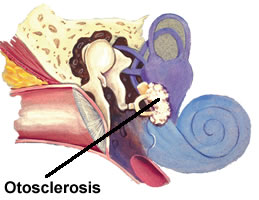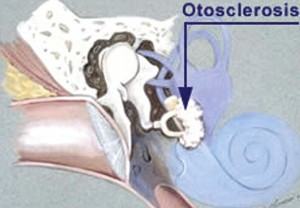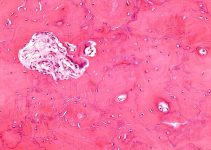Have you been lately suffering from difficulties in hearing that seem to be creating more problems with passing days? You could be a victim of Otosclerosis, a hereditary condition that affects hearing. Read and find out all about the disorder, including its possible causes, symptoms, treatment options and prognosis.
Otosclerosis Definition
Page Contents
- 1 Otosclerosis Definition
- 2 Otosclerosis Incidence
- 3 Otosclerosis ICD9 Code
- 4 Otosclerosis Types
- 5 Otosclerosis Symptoms
- 6 Otosclerosis and Tinnitus
- 7 What Happens in Otosclerosis?
- 8 Otosclerosis Causes
- 9 Otosclerosis Risk Factors
- 10 Otosclerosis Diagnosis
- 11 Otosclerosis Treatment
- 12 Otosclerosis Prognosis
- 13 Otosclerosis Complications
- 14 Otosclerosis Prevention
- 15 Otosclerosis Support Groups
- 16 Famous People with Otosclerosis
- 17 Otosclerosis Pictures
It is a condition arising due to an excessive growth in the bones located in the middle ear region, which obstructs the transmission of sound. As a result, the ears are abnormal and fail to vibrate properly. Patients fail to hear properly due to this disorder. In acute cases, there might even be a complete hearing loss.
The disorder is also known by other names like Otospongiosis and Stapedectomy.
Otosclerosis Incidence
According to the National Institute on Deafness and Other Communicative Disorders, around 10% of the general population in the United States suffers from this condition. However, it has been found to be rare in those belonging to other ethnic backgrounds. The condition is common in young adults and generally arises in early to mid-adulthood.
The disorder affects women more than men and may affect one or both ears of its sufferers.
Otosclerosis ICD9 Code
The ICD9 Code for this disease is 387.
Otosclerosis Types
The two sub-types of this disorder are:
Fenestral Otosclerosis
It is also referred to as Stapedial Otosclerosis. It commonly affects the bone placed in a position immediately anterior to the oval window. It can extend to the foot plate of the stapes and lead to fixation and thickening.
Retro-fenestral Otosclerosis
It is marked by sensorineural hearing loss (SNHL), although it is uncertain how this mechanism occurs.
Otosclerosis Symptoms
The typical signs and symptoms of this disease include:
- Ringing sensation in the ears (Tinnitus)
- Paracusis, marked by better hearing in noisy places
- Loss of hearing (gradual in the initial stages but worsens over a period of time)
- Dizziness or Vertigo, which are rare (arises when the balance mechanism in cochlea is impacted)
Hearing loss is the main symptom of this disorder. The severity of tinnitus is not necessarily associated to the severity or the type of hearing loss.
Otosclerosis is the most common cause of conductive hearing loss in individuals aged between 15 and 50 years. However, the condition can go undiagnosed in case of an absence of symptoms if the growth of the bones only affect the anvil or hammer. Conditions affecting the stapes are also related with progressive loss of hearing.
Otosclerosis and Tinnitus
Tinnitus develops in 4 out of 5 individuals affected with this disorder. It is an abnormal ringing sensation that arises even without any external source causing it. Patients with Tinnitus hear various sounds, such as whistles, ringing, roaring, ringing and noises that are caused by machines. The sensation tends to worsen with the progression of hearing loss.
What Happens in Otosclerosis?
The middle ear is comprised of the eardrum as well as a chamber that contains these three bones:
- Hammer
- Anvil
- Stirrup (or Stapes)
The audio waves passing through the ear make the ear drum vibrate with the impact. The three bones transmit this vibration to the inner ear. The vibrations are transformed into impulses in the inner ear and are ultimately transmitted to the brain by the nerves.
If excessive growth of bones interfere with the ability of the stapes to vibrate and transmit audio waves, as happens in Otosclerosis, affected individuals may suffer from hearing loss.
Otosclerosis Causes
Medical researchers are still baffled regarding the exact causative factor for this disease. However, certain evidence suggests that it may be hereditary in nature and passed down through generations of the same family.
Individuals affected by this disorder are detected with an abnormal spongy bone growing in the middle ear area. In healthy people, the ear bones tend to vibrate in response to sound waves and help them perceive auditory sensations. In people suffering from Otosclerosis, excessive bone growth prevents these vibrations. This leads to partial hearing loss in the initial and total deafness in the later stages.
Those having only one parent suffering from Otosclerosis are at 25% risk of developing the disease. Individuals with both parents suffering from the condition have a 50% risk of having the disorder.
Otosclerosis Risk Factors
The risk factors for this disease include:
Pregnancy
Pregnant women have been found to be more susceptible to this disorder.
Being young
As aforesaid, young adults are at greater risk of developing this disorder – especially those above 15 years of age.
Family history
A family history of this disease can put you at greater risk of having the disease. Researchers have some evidence of heredity being a causative factor for the condition.
Racial origin
People belonging to certain races are more likely to develop this disease. Caucasians are often detected with hearing loss, resulting from Otosclerosis.
Otosclerosis Diagnosis
The loss of hearing, associated with Otosclerosis, is generally noticed first in the late teenage years or during the early twenties. The loss is generally of a low-intensity, becoming high-intensity later and finally turning into middle intensity. The diagnosis can be confirmed by extensive hearing tests.
Hearing exams like audiology or audiometry may help in determining the intensity of hearing loss. In some cases, a Temporal-bone CT (a special imaging exam of the head) may be used to detect other reasons for hearing loss.
Otosclerosis Treatment
The condition is often asymptomatic and patients may not experience any problems, until at a later stage of the disorder. Naturally, treatment may be sought only when there are significant problems in hearing.
The treatment options for this condition involve:
Medications
Calcium, Vitamin D or Fluoride may help reduce loss of hearing in patients. However, the effectuality of such drugs has not been proved as yet.
Hearing aid
These may be used to cure partial deafness resulting from this disorder. These are supportive devices and help alleviate some of the problems, although they are unable to prevent or cure the worsening of the symptoms. Custom hearing aids can be used to amplify sounds for patients.
Surgery
Operative procedures for this disorder invlve removal of part of the overgrown stapes and using prosthesis to replace it. This can help treat conductive loss of hearing. A total replacement is known as Stapedectomy. The operation is carried out under the effects of local anesthesia and is generally an outpatient procedure. It is carried out only one ear at a time with a waiting period of one year between procedures.
The intensity of hearing improvement becomes maximum in around 4 months after operation. More than 80% of these methods manage to improve or restoring the ability to hear successfully.
In some cases, only a section of the stapes is removed and a small hole is created in its underside. This method is known as Stapedotomy. In some cases, operation includes use of laser.
If operation fails to cure the condition, sufferers may experience complete loss of hearing abilities. In such cases, treatment involves helping patients develop skills to cope with deafness. Supportive measures include use of hearing aids to transmit sounds to the unaffected ear from the affected one.
Otosclerosis Prognosis
Those affected with this disease are rarely found to become completely deaf. Patients are generally able to hear with the help of a hearing aid. Some individuals require a surgery as well as a hearing aid to be able to perceive auditory sensations. In elderly sufferers, the risk of additional loss of hearing is reduced due to the hardening of the bones.
In the absence of treatment, the condition gets worse. Operative procedures may help restore the ability to hear at least partially. Dizziness and pain resulting from surgery generally resolve within a few weeks.
Otosclerosis Complications
The possible complications, which this condition may give rise to, include the following:
- Total loss of hearing
- Nerve damage
- Funny taste in the mouth
- Infection, blood clot, pain or dizziness in the ear following surgery
The risk of post-surgical complications may be reduced by adapting the following measures:
- Avoiding people with respiratory infections or other similar infectious disorder
- Not blowing the nose for 2-3 weeks following surgery
- Avoiding activities that may cause dizziness, such as lifting, straining or bending
- Avoiding loud noises or activities that may result in changes in pressure, such as flying, scuba diving or driving in hilly regions until recuperation
Depending on the structure inside the ear that has been affected, Otosclerosis can result in various forms of hearing loss.
Treatment with medications may also give rise to a number of side effects in patients, which include:
- Allergic itching
- Increased pains in joint
- Occasional stomach upset
Otosclerosis Prevention
It is impossible to prevent this disorder as it is not known which gene is responsible for the development of this condition.
Otosclerosis Support Groups
Patients can contact the following organizations for support and information related to Otosclerosis or any of its symptoms:
American Tinnitus Association
Address: P.O. Box 5, Portland, OR 97207.
Contact no: (503) 248-9985.
Email id: [email protected].
National Association of the Deaf
Address: 814 Thayer Ave., Silver Spring, MD, 20910.
Contact no: (301) 587-1788.
Official website: http://nad.policy.net.
NIDCD Hereditary Hearing Impairment Resource Registry
Address: c/o Boys Town National Research Hospital. 555 N. 30th St., Omaha NE 68131.
Contact no: (800) 320-1171.
Self Help for Hard of Hearing People, Inc.
Address: 7800 Wisconsin Ave., Bethesda, MD 20814.
Contact no: (301) 657-2248.
Official website: http://www.shhh.org.
Famous People with Otosclerosis
The disorder has been manifested in people like:
- Beethoven (German composer)
- Harriet Martineau (Victorian journalist)
- Howard Hughes (American aviator)
- Frankie Valli (lead singer of The Four Seasons)
- Alexandra (Queen of Denmark, U.K)
Otosclerosis Pictures
The following images would help you understand how a bone growth in the ear affects hearing in Otosclerosis sufferers.
Picture 1 – Otosclerosis
Picture 2 – Otosclerosis Image
If you suspect yourself or any family member to be exhibiting the signs of this disease, get in touch with a doctor on an immediate basis. Loss of hearing can severely affect your health and ability to interact with others. Naturally, it is always sensible to seek faster medical treatment and ensure quicker recovery if you suspect a case of Otosclerosis.
References:
http://www.encyclopedia.com/topic/Otosclerosis.aspx
http://www.nlm.nih.gov/medlineplus/ency/article/001036.htm
http://en.wikipedia.org/wiki/Otosclerosis
http://www.wisegeek.com/what-is-otosclerosis.htm



